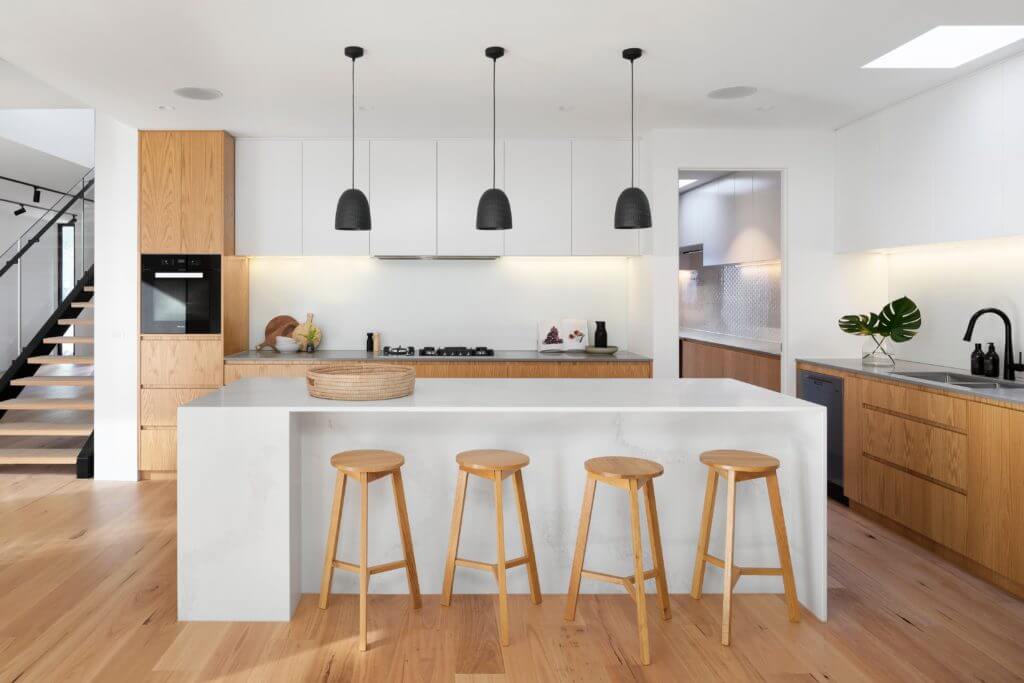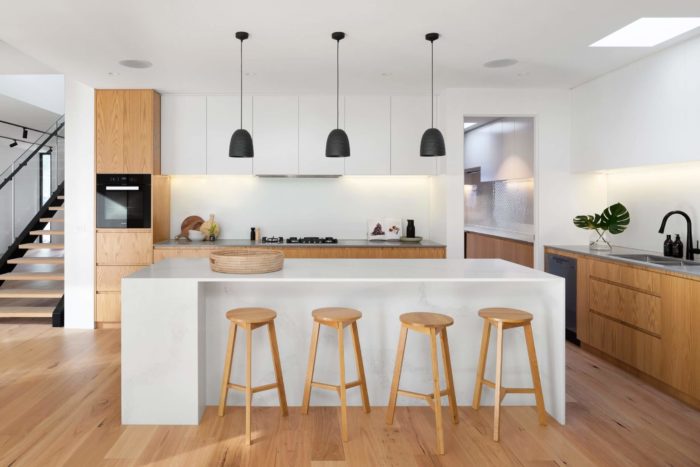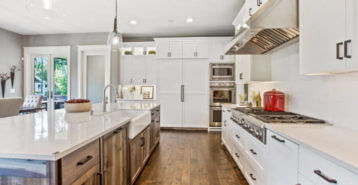Are you doing a kitchen remodel project?
Modernize can pair you with three to four pros in your area, so you can compare options and save time and money.
Islands — they’re the star of the show when it comes to kitchens. Whether you’re using it as a place where family and friends can gather, a workspace for kids doing their homework, or as storage for utensils and tools, it is one of the most helpful kitchen elements at your disposal. So what do you do if your kitchen doesn’t have an island, but you want one? Or if you have a kitchen island that isn’t working for you? Keep reading on for the details on designing a kitchen island to make it work in your space, no matter the size.

Are Islands Only for Larger Kitchens?
Not at all! While the standard kitchen island is 12×15 feet, islands come in all sizes, from substantial ones that house a cooktop, dishwasher, sink and storage to smaller console islands.
The latter option is a fit for rustic style kitchens, and it can be useful with a cutting board top, hooks on the sides to hold accessories, and shelving for commonly used kitchen utensils. Some of these islands even have wheels installed, making it easy to roll out of the way if you need more floor space.
When deciding if you have the space for an island, check to see you have at least two feet of space surrounding it. Not only does this give you room to walk, but it gives you space to open cabinets with ease.
Kitchen Island Features to Include
A kitchen island can serve a number of functions. At its most simple, there’s the rolling kitchen island that we shared above. But the bigger the island, the more features can be added to it. It can serve as an informal dining space with storage—this is also nice to have for entertaining – with guests sitting around the island noshing on snacks and drinks before dinner. At its most complex, kitchen islands will be hooked up to electricity and plumbing in order to have a sink, dishwasher, and other kitchen appliances. Some kitchen islands include vertical storage, pull-out trash cans, extra deep drawers for storing pots, baking dishes, or Tupperware, or even built-in dining tables attached to one side.
Can’t decide what to include? Keep a note handy on your phone or a notepad somewhere easily accessible in your kitchen. Each time you encounter an annoyance as you’re cooking or packing lunches, jot it down. Within a couple weeks, you should have a complete list of what you wish your kitchen accomplished, and can decide which of those problems could be solved within a kitchen island design.
Kitchen Island Cost
Like any home improvement project, the cost is dependent on a number of factors. The cost will be impacted by the following:
Find the Right Contractor for Your Kitchen Remodeling Project
Whether you’re ready to begin your project now or need some expert advice, our network of contractors are here to help. With a few simple questions, we’ll find the best local professionals for you
- How large is the kitchen island? The larger it is, the more expensive it is.
- Are you buying one store-bought or having a custom island made? It’s more affordable to purchase a store-bought kitchen island. Hiring a designer is also an added cost.
- What appliances are you adding? Not only do you need to purchase the sink, cooktop, dishwasher, and other accessories, but you’ll be paying plumbers and electricians for their time as well.
- What impact will installation have on your flooring? During the project, you’ll probably have parts of the floor ripped up or otherwise damaged.
A basic rolling kitchen island with simple shelf storage can be found for around $100, and customized islands can run as high as $10,000 when you add in demolition and installation work to your kitchen remodel.
Do Kitchen Islands Add Value?
Kitchens are one of the most important features of a home for homebuyers. It’s arguably one of the most used rooms in the home, and one that has updated appliances and beautiful design is going to be a huge selling point. In fact, on average, homeowners will recoup up to 72% of the cost they put into the project, one of the highest in the home.
There’s not just the monetary value of the kitchen island, but also putting your square footage to work in your home. Islands dramatically increase the storage space available to you, as well as providing more space to eat when you have guests over and a place for the kids to work on their homework. It also adds a luxe touch to your kitchen, no matter the style.
DIY Kitchen Island
Considering all the moving parts involved in installing a kitchen island—the materials, flooring, plumbing, and electrical work—this one is one best left to the professionals. However, if you’re looking for a free-standing kitchen island you can customize yourself, that is a much more DIY-friendly project. Something made out of wood can be sanded down and repainted, and it would make for a great base to add a farmhouse style or chevron wood design. Additionally, you’ll be able to add on things you might wish it had, like a towel rack, storage pockets for cutting boards, or hooks to hold mugs/cooking utensils.
If you’re in search of a reliable and knowledgeable contractor for designing a kitchen island, Modernize can help.
Find the Right Contractor for Your Kitchen Remodeling Project
Whether you’re ready to begin your project now or need some expert advice, our network of contractors are here to help. With a few simple questions, we’ll find the best local professionals for you
Reviews from Real Homeowners
Welcome to Homeowner Resources! We are the Modernize blog. Modernize pairs more than 3 million homeowners a year with pre-vetted contractors in their area. This blog started because we believe homeowners should know everything about their homes, from how their HVAC works to which front door colors they might love. On Homeowner Resources, you can find information on every part of your home, right down to how you can negotiate with contractors to get the best price. Here's more about the blog.
Need a contractor? Learn more about how Modernize finds the right pro for you.



